| II Corps | |
|---|---|
| Active | 1950–present |
| Country | North Korea |
| Branch | Army |
| Type | infantry |
| Part of | Korean People's Army |
| Garrison/HQ | Pyongsan County, North Hwanghae Province |
| Engagements | Korean War |
The II Corps is a corps of the Korean People's Army. It was created on June 12, 1950 with Lt. General Kim Kwang-hyop in command. During the Korean War the unit was composed of the 2nd Infantry Division, the 5th Infantry Division, and the 12th Infantry Division. [1]
The 27th Infantry Division was part of the II Corps. It defended the Kumchon area north of Kaesong with the 19th Division. [2] The U.S. 1st Cavalry Division began attacking on October 9, 1950, along the main highway from Kaesong to Kumchon. The US 8th Cavalry had to stop repeatedly and wait for engineer troops to clear mines from the road. Halfway to Kumchon on the twelfth the 8th Cavalry was halted by a North Korea strongpoint, defended by tanks, self-propelled guns, and antiaircraft weapons. In spite of a sixteen-plane air strike and a 155-mm. howitzer barrage, the strongpoint held.
1st Battalion, 5th Cavalry encountered the 19th and 27th Division's defenses on October 11 as they were holding a long ridge with several knobs— Hills 179, 175, and 174—that dominated a pass fifteen miles northeast of Kaesong. The 5th Cavalry finally drove the defenders from the ridge during the afternoon of the twelfth, after much fierce fighting.
Probably consisted of at least 3 divisions on January 7, 1951, when one division attacked the adjacent ROK 8th Infantry Division. They were assisted by one of the divisions of the NKPA V Corps. The II Corps also attacked the ROK III Corps to the east with its remaining divisions. The II Corps managed to penetrate the ROK III Corps defenses and cause concerns about the stability of the UN lines. [3]
Globalsecurity.org has reported that the corps is part of the First Echelon of the KPA and now consists of the 3rd, 6th, and 8th Infantry Divisions. [1]
This is the Korean War order of battle. Subsidiary commands are listed on sub-pages. Where no date is shown for a command, assume it present at the start of the war, on June 25, 1950.
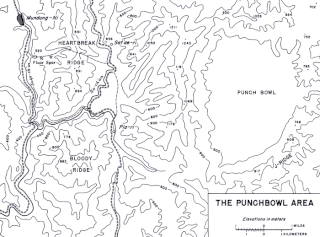
The Battle of Bloody Ridge was a ground combat battle that took place during the Korean War from 18 August to 5 September 1951.
Operation Commando was an offensive undertaken by United Nations Command (UN) forces during the Korean War between 3–12 October 1951. The US I Corps seized the Jamestown Line, destroying elements of the People's Volunteer Army (PVA) 42nd, 47th, 64th and 65th Armies. This prevented the PVA from interdicting the UN supply lines near Seoul.

Samuel Streit Coursen was a 1949 graduate of the United States Military Academy and company commander in the United States Army during the Korean War.
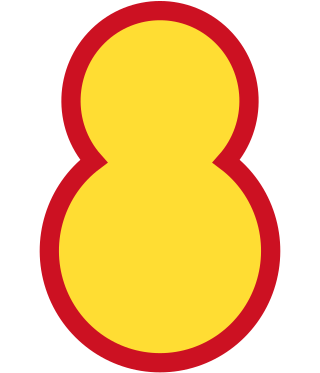
The 8th Maneuver Division, also known as Roly Poly Toy Division, is a military formation of the Republic of Korea Army and is unit is one of four divisions under the command of the VII Maneuver Corps. Before the unit was renamed on January 1, 2021, it was called the 8th Mechanized Infantry Division.
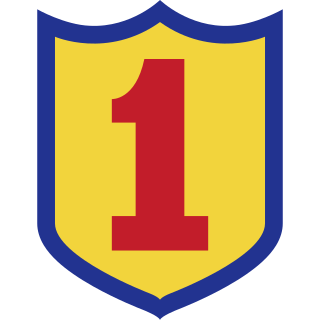
The 1st Infantry Division is a military formation of the Republic of Korea Army's I Corps. The division was established on 1947 under the command of Colonel Kim Suk-won.

The 6th Infantry Division is a military formation of the Republic of Korea Army.
The 19th Infantry Division was a military formation of the Korean People's Army.
The 27th Infantry Division was a military formation of the Korean People's Army, as part of the II Corps.
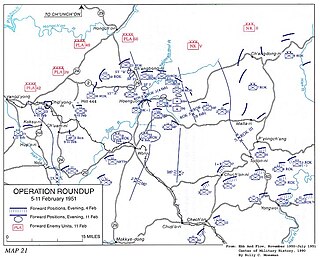
Operation Roundup was an advance by United Nations Command (UN) forces during the Korean War that took place from 5 to 11 February 1951. While achieving initial success against limited opposition, it was brought to a halt by Chinese People's Volunteer Army (PVA) and North Korean Korean People's Army (KPA) forces at the Battle of Hoengsong.

The Battle of the Ch'ongch'on River, also known as the Battle of the Ch'ongch'on, was a decisive battle in the Korean War that took place from November 25 to December 2, 1950, along the Ch'ongch'on River Valley in the northwestern part of North Korea. In response to the successful Chinese First Phase Campaign against the United Nations (UN) forces, General Douglas MacArthur launched the Home-by-Christmas Offensive to expel the Chinese forces from Korea and to end the war. Anticipating this reaction, the Chinese People's Volunteer Army (PVA) Commander Peng Dehuai planned a counteroffensive, dubbed the "Second Phase Campaign", against the advancing UN forces.
The Battle of Kumsong, also known as the Jincheng Campaign, was one of the last battles of the Korean War. During the ceasefire negotiations seeking to end the Korean War, the United Nations Command (UNC) and Chinese and North Korean forces were unable to agree on the issue of prisoner repatriation. South Korean President Syngman Rhee, who refused to sign the armistice, released 27,000 North Korean prisoners who refused repatriation. This action caused an outrage among the Chinese and North Korean commands and threatened to derail the ongoing negotiations. As a result, the Chinese decided to launch an offensive aimed at the Kumsong salient. This would be the last large-scale Chinese offensive of the war, scoring a victory over the UNC forces.
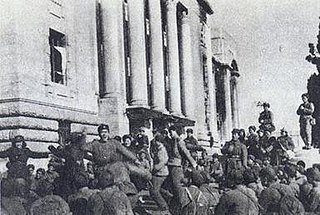
The Third Battle of Seoul was a battle of the Korean War, which took place from December 31, 1950, to January 7, 1951, around the South Korean capital of Seoul. It is also known as the Chinese New Year's Offensive, the January–Fourth Retreat or the Third Phase Campaign Western Sector.

The First and Second Battles of Wonju, also known as the Wonju Campaign or the Third Phase Campaign Eastern Sector, was a series of engagements between North Korean and United Nations (UN) forces during the Korean War. The battle took place from December 31, 1950, to January 20, 1951, around the South Korean town of Wonju. In coordination with the Chinese capture of Seoul on the western front, the North Korean Korean People's Army (KPA) attempted to capture Wonju in an effort to destabilize the UN defenses along the central and the eastern fronts.
The III Corps is a corps of the Korean People's Army. It was created just before the North Korean invasion of 1950 with Lt. General Yu Kyong-su in command. During the initial North Korean invasion of the south, it was in reserve, comprising the 10th Infantry Division, the 13th Division, and the 15th Infantry Division.
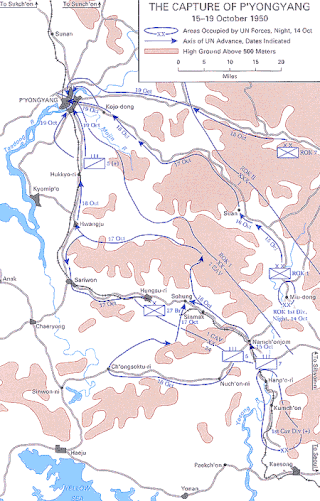
The Battle of Pyongyang was one of the major battles of the United Nations' offensive during the Korean War. Following the Battle of Inchon, the UN forces re-captured Seoul, the capital of South Korea, and proceeded to advance into North Korea. Shortly after advancing, the American and South Korean forces faced the North Korean defenses near Pyongyang, the capital of North Korea, on 17 October.

Operation Dauntless was a military operation performed by the United Nations Command (UN) during the Korean War designed to advance the UN lines to positions 10–20 miles (16–32 km) north of the 38th Parallel designated the Wyoming Line which would threaten the Chinese and North Korean logistics hub marked out by the towns of Pyonggang, Ch'orwon and Gimhwa-eup named the Iron Triangle. The operation immediately succeeded Operation Rugged which took the UN forces to the Kansas Line 2 to 6 miles north of the 38th Parallel. The operation was initially successful, reaching its initial objectives, but was brought to a halt by the Chinese Spring Offensive on 22 April 1951.

The Third Battle of Wonju, was a series of engagements between North Korean and United Nations (UN) forces during the Korean War. The battle took place from 13 to 18 February 1951 north of the South Korean town of Wonju.

The Pusan Perimeter offensive was a large-scale offensive by United Nations Command (UN) forces against North Korean forces commencing on 16 September 1950.
The UN offensive into North Korea was a large-scale offensive in late 1950 by United Nations (UN) forces against North Korean forces during the Korean War.